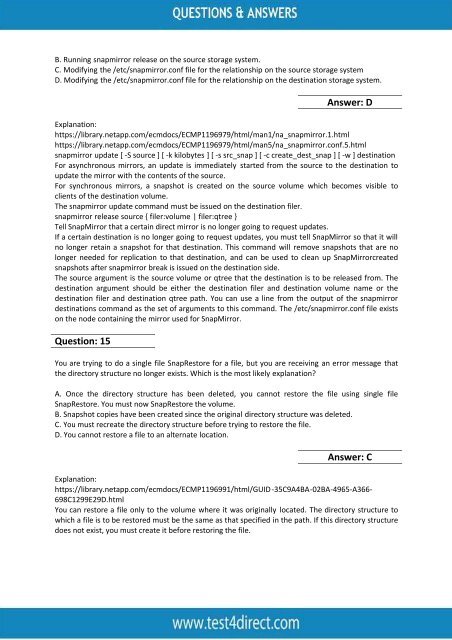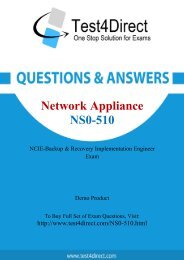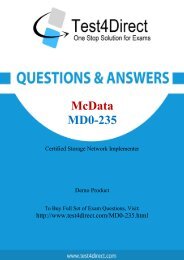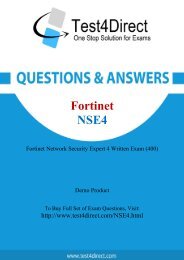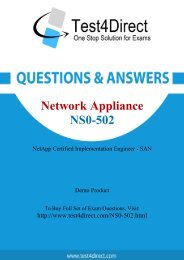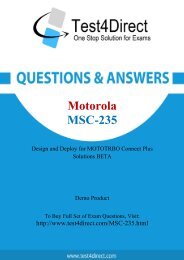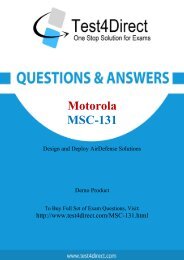NS0-155 BrainDumps For Best Results
Test4Direct provides latest PDF questions of Network Appliance NS0-155 exam. You have an opportunity to pass the Network Appliance NS0-155 exam in one go. Test4Direct is most accurate source to prepare Network Appliance NS0-155 exam as your success will become site’s responsibility after purchasing NS0-155 exam product. There are also lots of discounts and promotion offers that you can avail. Let’s try a free demo http://www.test4direct.com/NS0-155.html
Test4Direct provides latest PDF questions of Network Appliance NS0-155 exam. You have an opportunity to pass the Network Appliance NS0-155 exam in one go. Test4Direct is most accurate source to prepare Network Appliance NS0-155 exam as your success will become site’s responsibility after purchasing NS0-155 exam product. There are also lots of discounts and promotion offers that you can avail. Let’s try a free demo http://www.test4direct.com/NS0-155.html
You also want an ePaper? Increase the reach of your titles
YUMPU automatically turns print PDFs into web optimized ePapers that Google loves.
B. Running snapmirror release on the source storage system.<br />
C. Modifying the /etc/snapmirror.conf file for the relationship on the source storage system<br />
D. Modifying the /etc/snapmirror.conf file for the relationship on the destination storage system.<br />
Question: 15<br />
Answer: D<br />
Explanation:<br />
https://library.netapp.com/ecmdocs/ECMP1196979/html/man1/na_snapmirror.1.html<br />
https://library.netapp.com/ecmdocs/ECMP1196979/html/man5/na_snapmirror.conf.5.html<br />
snapmirror update [ -S source ] [ -k kilobytes ] [ -s src_snap ] [ -c create_dest_snap ] [ -w ] destination<br />
<strong>For</strong> asynchronous mirrors, an update is immediately started from the source to the destination to<br />
update the mirror with the contents of the source.<br />
<strong>For</strong> synchronous mirrors, a snapshot is created on the source volume which becomes visible to<br />
clients of the destination volume.<br />
The snapmirror update command must be issued on the destination filer.<br />
snapmirror release source { filer:volume | filer:qtree }<br />
Tell SnapMirror that a certain direct mirror is no longer going to request updates.<br />
If a certain destination is no longer going to request updates, you must tell SnapMirror so that it will<br />
no longer retain a snapshot for that destination. This command will remove snapshots that are no<br />
longer needed for replication to that destination, and can be used to clean up SnapMirrorcreated<br />
snapshots after snapmirror break is issued on the destination side.<br />
The source argument is the source volume or qtree that the destination is to be released from. The<br />
destination argument should be either the destination filer and destination volume name or the<br />
destination filer and destination qtree path. You can use a line from the output of the snapmirror<br />
destinations command as the set of arguments to this command. The /etc/snapmirror.conf file exists<br />
on the node containing the mirror used for SnapMirror.<br />
You are trying to do a single file SnapRestore for a file, but you are receiving an error message that<br />
the directory structure no longer exists. Which is the most likely explanation?<br />
A. Once the directory structure has been deleted, you cannot restore the file using single file<br />
SnapRestore. You must now SnapRestore the volume.<br />
B. Snapshot copies have been created since the original directory structure was deleted.<br />
C. You must recreate the directory structure before trying to restore the file.<br />
D. You cannot restore a file to an alternate location.<br />
Answer: C<br />
Explanation:<br />
https://library.netapp.com/ecmdocs/ECMP1196991/html/GUID-35C9A4BA-02BA-4965-A366-<br />
698C1299E29D.html<br />
You can restore a file only to the volume where it was originally located. The directory structure to<br />
which a file is to be restored must be the same as that specified in the path. If this directory structure<br />
does not exist, you must create it before restoring the file.


